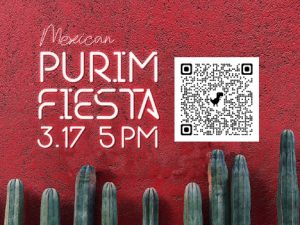The story of Purim takes us back approximately 2,400 years. The Persian Empire of the 4th century BCE extended over 127 lands, and all Jewish people living at the time were its subjects.
The story begins when King Ahasuerus executed his wife, Queen Vashti, for failing to follow his orders and arranged a beauty pageant to find a new queen. A Jewish girl, Esther, found favor in the king’s eyes and won the crown, though she refused to divulge her nationality or religion.
Meanwhile, a Jew-hating man named Haman was appointed prime minister of the empire. Mordechai, the leader of the Jews (and Esther’s cousin), defied the king’s orders and refused to bow to Haman. Haman was incensed and he convinced the king to issue a decree ordering the extermination of all of the Jewish people in his kingdom. He chose the date of the 13th day of the Hebrew month of Adar by casting lots. (Purim is Hebrew for “lots” – this is how the holiday got its name.) In addition to the decree against all of the Jews, Haman made a special gallows 30 feet tall, specifically for Mordechai, as punishment for his defiance.
Mordechai galvanized all the Jews, convincing them to repent, fast and pray to G‑d. Meanwhile, Esther asked the king and Haman to join her for a feast. Esther revealed her Jewish identity and that because of the feast’s other esteemed guest she and her people would be wiped out. Haman was hanged on the gallows he had built for Mordechai, and Mordechai was appointed prime minister in his stead. A new decree was issued, granting the Jews the right to defend themselves against their enemies.
On the 13th of Adar, the Jews mobilized and killed many of their enemies. On the 14th of Adar, they rested and celebrated.
Every year since then, Jewish people worldwide mark the holiday of Purim on the 14th of Adar with feasts and celebrations.
Following the miracle of Purim, the rabbis instituted four rabbinic mitzvot – commandments – that are to be fulfilled on Purim: 1) to read the Megillah (the detailed Purim story which was written by Mordechai and Esther); 2) to enjoy a festive meal; 3) to give gifts of at least two foods to one another (called Mishloach Manot); and finally – and perhaps most importantly – 4) to give charity to the poor (Matanot Le’evyonim).
While most Jewish holidays involve miraculous events that are contrary to nature (the splitting of the sea when leaving Egypt, the miracle of the Menorah in the story of Chanukah, etc.), the miraculous sequence of events in the story of Purim all worked within nature. One of the messages that we can take from this is the understanding that no matter what situation people may find themselves in, G-d is always watching and cares deeply about each and every one of us. Everything happens for a reason – no matter how “normal” the chain of events may seem, G-d always has a plan for us. We just need to look hard enough to discover the miracles that are taking place.
Wishing you a Happy Purim,
Rabbi Mendy Grossbaum
Chabad of the Crescenta Valley
 Chabad of the Crescenta Valley is excited to host a Mexican themed Purim party open to the community. It takes place in La Cañada Flintridge. Please visit cvchabad.org/purimfiesta to RSVP.
Chabad of the Crescenta Valley is excited to host a Mexican themed Purim party open to the community. It takes place in La Cañada Flintridge. Please visit cvchabad.org/purimfiesta to RSVP.
